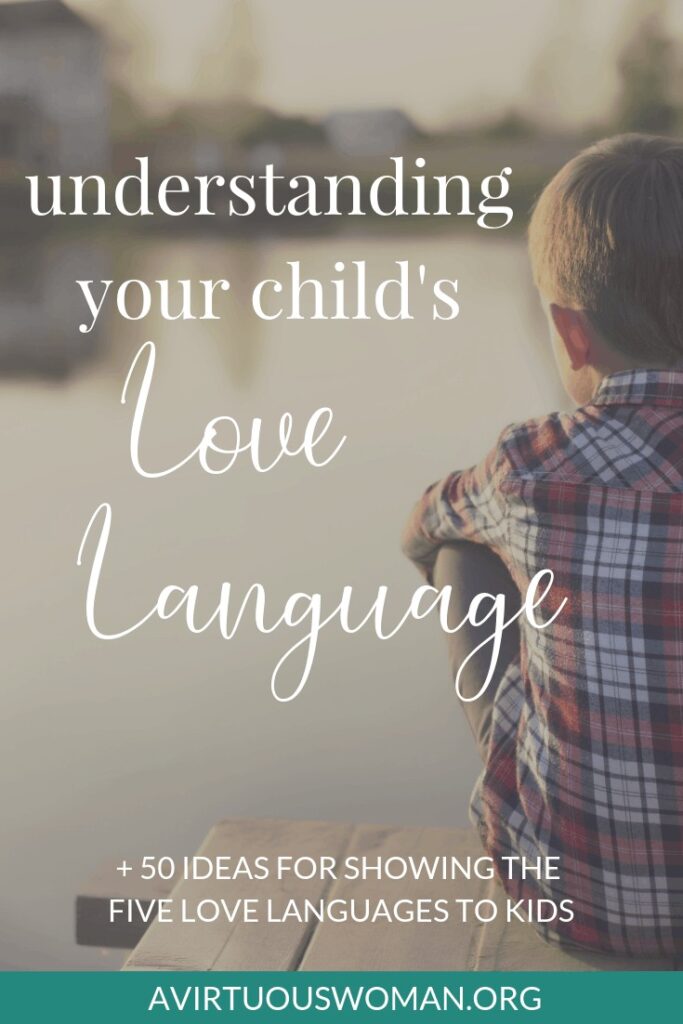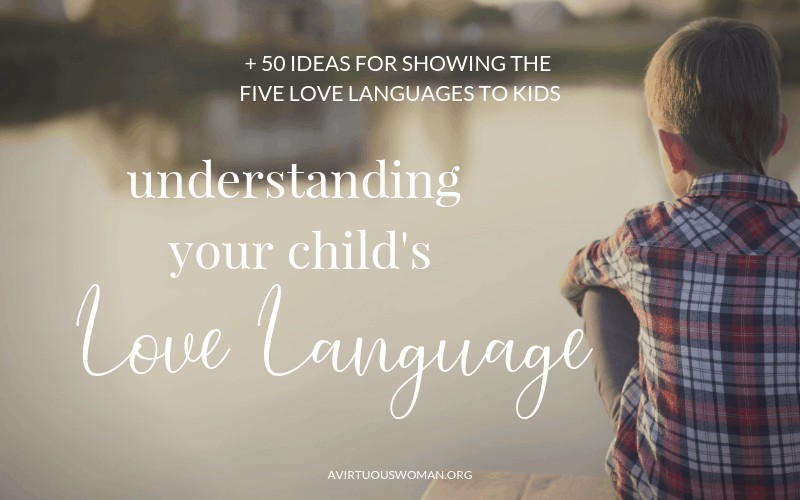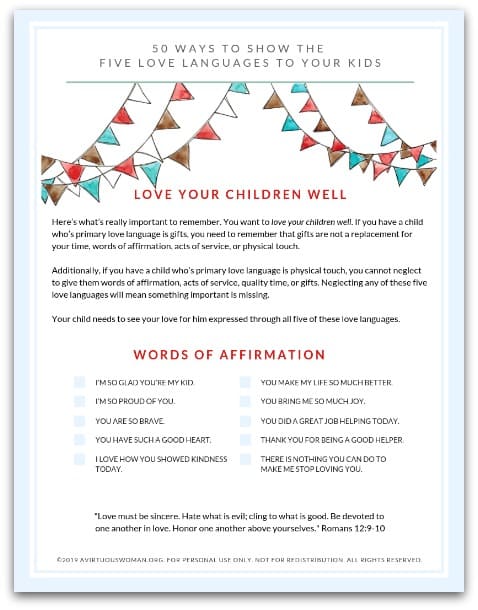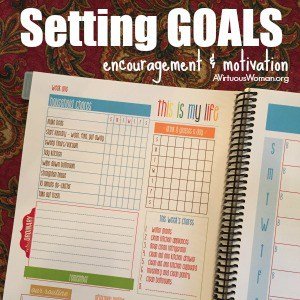Understanding Your Child’s Love Language
We all want to be good moms and have a great relationship with our kids. Understanding your child’s love language can help you best love each of your unique children. Today I’m talking about how you can use the love language quiz for kids to better understand your child.

I realized early on that each of my five kids was different. They each had their own likes, dislikes, tastes, and temperaments. And each one felt greatly loved in unique ways. If you’ve ever read Gary Chapman’s book, The Five Love Languages: The Secret to Love that Lasts, you know that people give and receive love different ways.
As parents it can be easy to assume that all children feel loved the same way but as we’ll learn, that’s not always the case. Parenting is hard.
Oh there are easy moments and moments that make our hearts swell. I love being a mom. Literally it’s the best part of my life! But parenting isn’t always easy and sometimes it’s down right hard.
Understanding Your Child’s Love Language
Just as we might like to use a love language quiz for our spouse, we can use a love language quiz for kids. It’s so important that children be understood especially since it’s harder for them to communicate.
Adults have the ability of being able to more easily communicate their wants, desires, and needs.
Kids, however, don’t have the knowledge or ability to always communicate how they feel. So, it falls to us as parents to learn all we can about them.
Understanding a child’s love language can teach us, as parents, how to handle them well. For example, if your child is acting out or misbehaving, knowing his love language can help you understand what would best reach his heart.
Of course, we all want our children to feel cherished and valued. Knowing their love language will help you effectively reach them in your actions or gestures to show them they’re loved more than anything in the world.
There are many ways to love a child. Wouldn’t it be great if you knew the best way to love your child?
The Bible tells us, “Love must be sincere. Hate what is evil; cling to what is good. Be devoted to one another in love. Honor one another above yourselves.” Romans 12:9-10
Let your love be sincere.
5 Love Languages of Kids Video
What Are the Five Love Languages of Kids?
Words of Affirmation
If your child’s primary love language is words of affirmation, children love to hear words that communicate their worth in your eyes. This isn’t just saying “I love you” {although that’s one way} but it’s also saying words that are encouraging and uplifting. Make sure to voice how proud you are of your child and express how beautiful and cherished they are.
Point out the unique qualities and characteristics of your child that makes him special. Use words to demonstrate that you see him and love who he is.
When your child does something thoughtful, kind, brave, or hard tell him how proud you are or how much you appreciate what they did.
It also means that if you’re trying to help your child understand what they did wrong when he’s being chastised, a clearly expressed talk will go a long way. You may also notice that your child will also show love and emotion through words.
Physical Touch
Physical touch is a pretty common love language for children of all ages. There’s nothing more comforting than a hug from mom or dad.
The feeling of security physical touch can give a child makes it vital in more ways than one. However, not all kids respond to physical touch as one of their more prominent love languages. That’s why taking the love language quiz for kids can be quite helpful in pointing you in the strongest direction for your unique child.
You may find that a child that has physical touch as one of their main love languages will love to snuggle. If they’re scared, they may want to hop into bed with you. In return, they may show love and other emotions through physical touch as well.
Gary Chapman says, “Hugs and kisses are the most common way of speaking this love language, but there are other ways, too. A dad tosses his year-old son in the air. He spins his seven-year-old daughter round and round, and she laughs wildly. A mom reads a story with her three-year-old on her lap.”
Also, remember that a child who’s primary love language is through touch will be very “touchy feely” and may love to give people hugs. It’s important that your child understand the difference between good touch and bad touch. You want your child to stay safe and understand what’s okay.
Of course, this is an important talk to have with your kids regardless of what their primary love language is!
Quality Time
This one sort of speaks for itself. Most children will crave time spent with you. If this is your child’s main love language, it’s important to make sure you spend time with them personally. Not in a group or with your other children but, one on one time with them.
Quality time spent with your child means that you are fully present and focused on your child and building your relationship. This also means you aren’t focused on your phone or on other things you need to do. Look your child in the eyes and let them know they are valued and that you enjoy spending time together.
Very often, children who are not receiving enough quality time and attention from their parents will misbehave – because for a child, negative attention is better than no attention. Children want to know you value time spent with them.
Moms, remember that your children grow up fast! You can’t get back the days that are lost. Set down your phones. Put off washing the dishes for a bit. Get on the floor and play a game. Go outside and take a walk together. Look in your child’s eyes and listen when she speaks.
related: Enjoy Your Children
Gifts
I don’t know many people who don’t love getting gifts. However, children who speak the love language of gifts will want to give and receive gifts often.
This means that during special times, even small gifts for them will make them feel important and very loved. They may be the type of child to always bring you in flowers from the yard.
Gift giving can be a lot of fun. And seeing your child’s face light up when you give them something special or give them a present is priceless.
It’s important to remember that when you give gifts that there are no strings attached. When gifts are used to manipulate a child’s behavior or feelings, it’s not really a gift.
And if you’re child’s primary love language is gifts, remember that you cannot lavish your child with every thing they ask for. A gift may light up her face, but giving too many gifts will teach your child to focus more on materialism instead of relationships.
Heidi Krumenauer with Focus on the Family says, “Children with this love language treasure gifts as a tangible token of affection. Unfortunately, they also interpret a lack of gifts as a lack of love. Your gifts don’t need to be expensive, and they don’t need to be given every day, but recognizing that a child prefers to be rewarded with a pack of gum rather than a hug is an important step in building communication.”
Instead of always offering your child presents and toys to no end, give your child small gifts that are meaningful and have less material value. For instance, Gary Chapman’s website says:
“If a child’s love language is gifts, the gifts don’t have to be expensive and they certainly don’t have to be everything a child is asking for. That would be a serious mistake. You can give them little things: a stone you pick up in a parking lot, a flower from the garden, just one bite of candy. Little things will mean a lot to this child. In terms of gifts, you give them something you think will be helpful for them. Don’t give them everything they ask or that will teach them materialism. But give them those things that will be beneficial for them.”
Acts of Service
If this is one of your child’s main love languages, they put a lot of importance on actions. This means that they won’t soon forget an action forgotten or done towards them.
Children with this love language will have a servant’s heart as well. They may be great helpers around the house and be people pleasers. Giving them opportunities to volunteer and help out where needed will be a great blessing to them.
It’s important to help these children to not obsess over becoming a perfectionist or overwhelmed with failure. This can happen to them very easily since their mind is focused on acts.
Take the Love Language Quiz for Kids
Depending on the age of your child, you can take the love language quiz for kids with them to help them understand what the quiz is, how to answer, etc. This is helpful for younger kids.
If your child is older, they most likely will grasp the idea of the quiz and should be able to do it on your own. However, I would still make sure they understand the importance of it before they begin.
Gary Chapman’s website has two love language tests for kids based on their ages:
Alternatively, you can have your child take this printable love language quiz – just print it out and help them understand what they are doing before they get started.
How to Use the Printable Love Language Quiz for Kids
Once your child has finished the love language quiz, add up how many times they answered each letter. For example, if they circled “E” on an answer, add up how many they answered with “E” and write that at the bottom in the appropriate spot.
There will be A, B, C, D, and E to choose from as they go through the quiz. Each letter stands for a different love language. Whichever letter has the highest score is their number one love language.
The next highest number is their second love language. In other words, the scores go from highest to lowest, with the highest being their most important love language, and the lowest being their least prominent.
Once you know your child’s love language, you can explain to them what the scores mean. Even adults find comfort and direction in their self-worth and image when they discover their love language.
If your child is younger, it may be a harder concept for them to learn but, you can gradually teach them the concept as they age.
But most importantly, you will know how to approach your child in an effective manner. Not only to discipline them but, more importantly, show them how much they’re loved and appreciated.
1 Corinthians 13:1-3 says, “If I speak in the tongues of men and of angels, but have not love, I am a noisy gong or a clanging cymbal. And if I have prophetic powers, and understand all mysteries and all knowledge, and if I have all faith, so as to remove mountains, but have not love, I am nothing. If I give away all I have, and if I deliver up my body to be burned, but have not love, I gain nothing.”
Love Your Children Well
In the book, The Five Love Languages of Children: The Secret to Loving Children Effectively, the Gary Chapman says:
“The Five Love Languages of Children will introduce to all five love languages of children and help you determine the primary languages in which your child hears your love… Practice all five love languages and you can be sure your child will sense your love.”
Here’s what’s really important to remember. You want to love your children well. If you have a child who’s primary love language is gifts, you need to remember that gifts are not a replacement for your time, words of affirmation, acts of service, or physical touch.
Additionally, if you have a child who’s primary love language is physical touch, you cannot neglect to give them words of affirmation, acts of service, quality time, or gifts. Neglecting any of these love languages will mean something is missing.
Your child needs to see your love for him expressed through all five of these love languages. As I raised my own children, I made sure every day that I said good words to my kids, hugged them fiercely, gave them my time and focused attention, listened when they spoke, and did kind things for them.
If you do these things, you’ll have a great relationship with your kids.

50 Ideas for Showing the Five Love Languages to Kids
Words of Affirmation
You can say these words to your child to show love.
- I’m so glad you’re my kid.
- I’m so proud of you.
- You are so brave.
- I love how you showed kindness today.
- You make my life so much better.
- You bring me so much joy.
- You did a great job helping today.
- Thank you for being a good helper.
- You have such a good heart.
- There is nothing you can do to make me stop loving you.
Physical Touch
You can show your child love with these physical touch ideas.
- hugs and kisses
- a pat on the back
- high five
- snuggle time
- sitting on your lap
- reading a book and sitting close
- holding hands
- a caress on the forehead
- back and foot massages
- secret or special handshake
Quality Time
You can show your child love by spending quality time together.
- go on a one on one date together
- play board games
- sit together and read a book
- snuggle time
- ask an open ended question and really listen
- cook together
- get on the floor and play
- let your child pick how to spend an hour with you
- focus on your child during his practice time and watch or listen
- have a real conversation
Gifts
You can show your child love by giving meaningful and thoughtful gifts.
- give your child gifts that are meaningful but not expensive
- give your child a special food they love – like avocados or a favorite piece of fruit
- give a gift they’ve wanted for a long time
- share something you found that reminds you of your child
- include a kind note in his lunch box
- stop at the Dollar Tree to get one item
- give your child a special piece of candy or a pack of gum
- give your child a book
- share “just because” gifts with your child from time to time
- go out for ice cream together
Acts of Service
You can show your child love through these expressions of service.
- repair a broken toy
- make your child’s favorite meal
- do something thoughtful
- bake cookies together
- positively respond to requests for help
- perform an act of service for someone else together
- volunteer in the community together
- bring him a cold drink when he’s thirsty
- do a chore for them that they were supposed to do
- let your child help you – even when it feels like more work for you
These ideas for showing your child love are just the tip of the iceberg. Every child and family is unique. Think about your daily life and how you can show your child love through the five love languages every day.
Action Steps to Take Today
- Take the Love Language Quiz for kids. Print the quiz or take the online quiz.
- Read the book, The Five Love Languages of Children: The Secret to Loving Children Effectively by Gary Chapman and Ross Campbell. I highly recommend!
- Think of ways you can show love to your child based on his or her primary love language.
- Brainstorm ideas for ways you can intentionally show love to your child using all five of the love languages of children.
- Download my free printable 50 Ideas for Showing the Five Love Languages to Kids below.
- Ask your child how they feel loved and what you do that makes them feel the most loved.
Free Printable Love Languages for Kids

How to Download
- Just fill out the form below and you’ll receive an email with the link to download your free printable checklist. You’ll also receive helpful emails and updates from me on a regular basis!
- Or, you can purchase this printable Love Languages for Kids here for just $2.97.
- If you are already a subscriber, you can still fill out the form below to get the download – it won’t affect your subscription!
Love Languages for Kids

Join A Virtuous Woman's community of over 21,000 women where you'll find freedom from perfection and the confidence to live your life with purpose. Get my FREE PRINTABLE: 50 Ideas for Showing the Five Love Languages to Kids!







